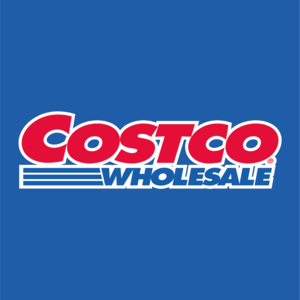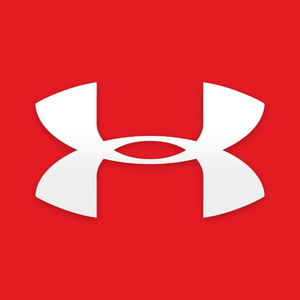
Crocs (CROX)
Crocs keeps us up at night. Its weak sales growth and low returns on capital show it struggled to generate demand and profits.― StockStory Analyst Team
1. News
2. Summary
Why We Think Crocs Will Underperform
Founded in 2002, Crocs (NASDAQ:CROX) sells casual footwear and is known for its iconic clog shoe.
- Lackluster 1.6% annual revenue growth over the last two years indicates the company is losing ground to competitors
- Forecasted revenue decline of 2.6% for the upcoming 12 months implies demand will fall off a cliff
- Weak constant currency growth over the past two years indicates challenges in maintaining its market share


Crocs doesn’t pass our quality test. We’re looking for better stocks elsewhere.
Why There Are Better Opportunities Than Crocs
High Quality
Investable
Underperform
Why There Are Better Opportunities Than Crocs
Crocs is trading at $88.38 per share, or 7.3x forward P/E. This sure is a cheap multiple, but you get what you pay for.
Our advice is to pay up for elite businesses whose advantages are tailwinds to earnings growth. Don’t get sucked into lower-quality businesses just because they seem like bargains. These mediocre businesses often never achieve a higher multiple as hoped, a phenomenon known as a “value trap”.
3. Crocs (CROX) Research Report: Q3 CY2025 Update
Footwear company Crocs (NASDAQ:CROX) reported Q3 CY2025 results exceeding the market’s revenue expectations, but sales fell by 6.2% year on year to $996.3 million. On top of that, next quarter’s revenue guidance ($1.07 billion at the midpoint) was surprisingly good and 15.8% above what analysts were expecting. Its non-GAAP profit of $2.92 per share was 23.7% above analysts’ consensus estimates.
Crocs (CROX) Q3 CY2025 Highlights:
- Revenue: $996.3 million vs analyst estimates of $964.4 million (6.2% year-on-year decline, 3.3% beat)
- Adjusted EPS: $2.92 vs analyst estimates of $2.36 (23.7% beat)
- Adjusted EBITDA: $228 million vs analyst estimates of $200.4 million (22.9% margin, 13.8% beat)
- Revenue Guidance for Q4 CY2025 is $1.07 billion at the midpoint, above analyst estimates of $923 million
- Adjusted EPS guidance for Q4 CY2025 is $1.87 at the midpoint, above analyst estimates of $1.75
- Operating Margin: 20.8%, down from 25.4% in the same quarter last year
- Free Cash Flow Margin: 22.7%, down from 26.3% in the same quarter last year
- Constant Currency Revenue rose 1.2% year on year, in line with the same quarter last year
- Market Capitalization: $4.63 billion
Company Overview
Founded in 2002, Crocs (NASDAQ:CROX) sells casual footwear and is known for its iconic clog shoe.
The original Crocs shoe, made from the company's proprietary closed-cell resin called Croslite, was initially intended for boating and outdoor wear due to its slip-resistant, non-marking sole. However, the comfort and functionality of the shoes quickly made them a cross-cultural phenomenon, expanding their use to casual wear, professional use, and even as a fashion statement.
Crocs has capitalized on the popularity of its signature clog by offering a broad assortment of footwear styles, including sandals, wedges, slides, and boots. The brand is also known for its wide range of colors and the ability to personalize shoes with "Jibbitz" charms, small decorative pieces that fit into the holes of the Crocs clogs.
The company sells its products in more than 90 countries through wholesalers, retail stores, and directly to consumers through its website and company-owned stores. Despite its simple product line, Crocs has maintained its relevance through strategic collaborations with designers, celebrities, and brands, elevating the relevance of its products.
4. Footwear
Before the advent of the internet, styles changed, but consumers mainly bought shoes by visiting local brick-and-mortar shoe, department, and specialty stores. Today, not only do styles change more frequently as fads travel through social media and the internet but consumers are also shifting the way they buy their goods, favoring omnichannel and e-commerce experiences. Some footwear companies have made concerted efforts to adapt while those who are slower to move may fall behind.
Crocs primary competitors include Skechers (NYSE:SKX), Deckers (NYSE:DECK), Birkenstock (private), and private companies Sanuk and Teva.
5. Revenue Growth
A company’s long-term sales performance is one signal of its overall quality. Even a bad business can shine for one or two quarters, but a top-tier one grows for years. Luckily, Crocs’s sales grew at an excellent 26.9% compounded annual growth rate over the last five years. Its growth beat the average consumer discretionary company and shows its offerings resonate with customers.

We at StockStory place the most emphasis on long-term growth, but within consumer discretionary, a stretched historical view may miss a company riding a successful new product or trend. Crocs’s recent performance shows its demand has slowed significantly as its annualized revenue growth of 1.6% over the last two years was well below its five-year trend. 
We can dig further into the company’s sales dynamics by analyzing its constant currency revenue, which excludes currency movements that are outside their control and not indicative of demand. Over the last two years, its constant currency sales averaged 3% year-on-year growth. Because this number aligns with its normal revenue growth, we can see that Crocs has properly hedged its foreign currency exposure. 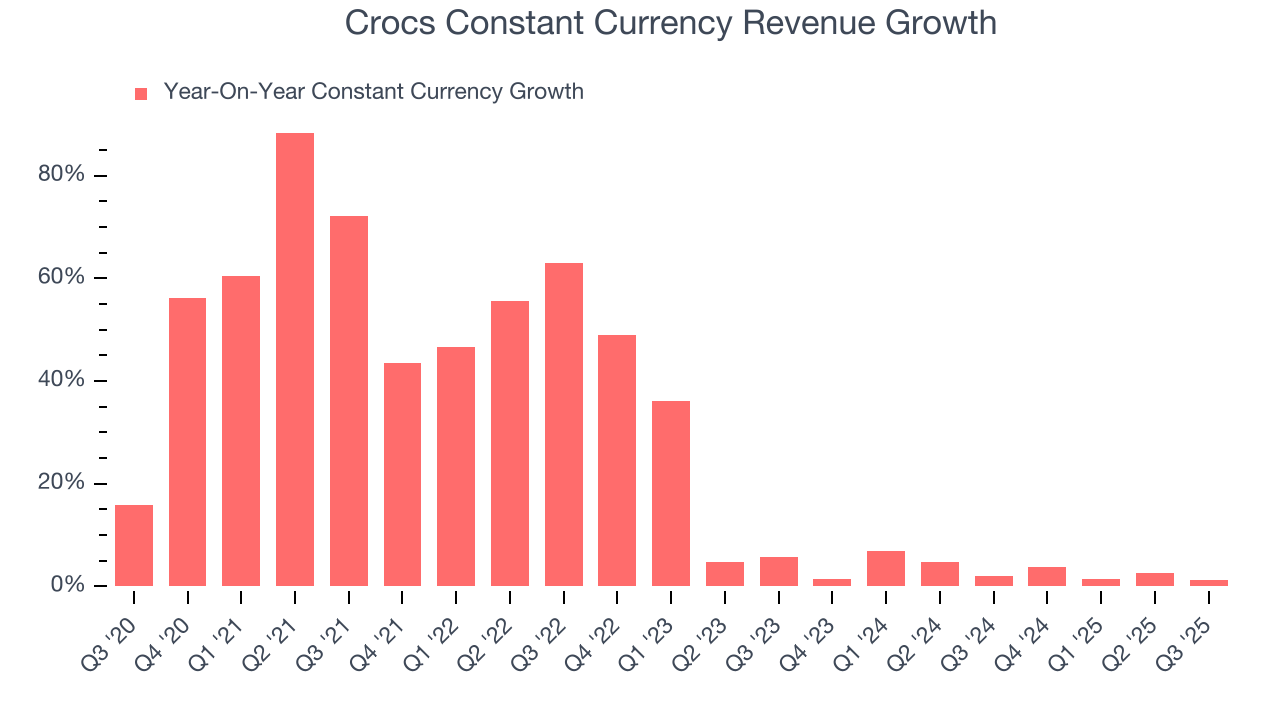
This quarter, Crocs’s revenue fell by 6.2% year on year to $996.3 million but beat Wall Street’s estimates by 3.3%. Company management is currently guiding for a 8% year-on-year increase in sales next quarter.
Looking further ahead, sell-side analysts expect revenue to decline by 2.3% over the next 12 months, a deceleration versus the last two years. This projection doesn't excite us and implies its products and services will face some demand challenges.
6. Operating Margin
Operating margin is an important measure of profitability as it shows the portion of revenue left after accounting for all core expenses – everything from the cost of goods sold to advertising and wages. It’s also useful for comparing profitability across companies with different levels of debt and tax rates because it excludes interest and taxes.
Crocs’s operating margin has shrunk over the last 12 months, but it still averaged 15.2% over the last two years, solid for a consumer discretionary business. This shows it generally manages its expenses well, and its top-notch historical revenue growth also suggests its margin dropped because it ramped up investments to capture market share. We’ll keep a close eye to see if this strategy pays off.

In Q3, Crocs generated an operating margin profit margin of 20.8%, down 4.6 percentage points year on year. This contraction shows it was less efficient because its expenses increased relative to its revenue.
7. Earnings Per Share
We track the long-term change in earnings per share (EPS) for the same reason as long-term revenue growth. Compared to revenue, however, EPS highlights whether a company’s growth is profitable.
Crocs’s EPS grew at an astounding 40.8% compounded annual growth rate over the last five years, higher than its 26.9% annualized revenue growth. However, this alone doesn’t tell us much about its business quality because its operating margin didn’t improve.
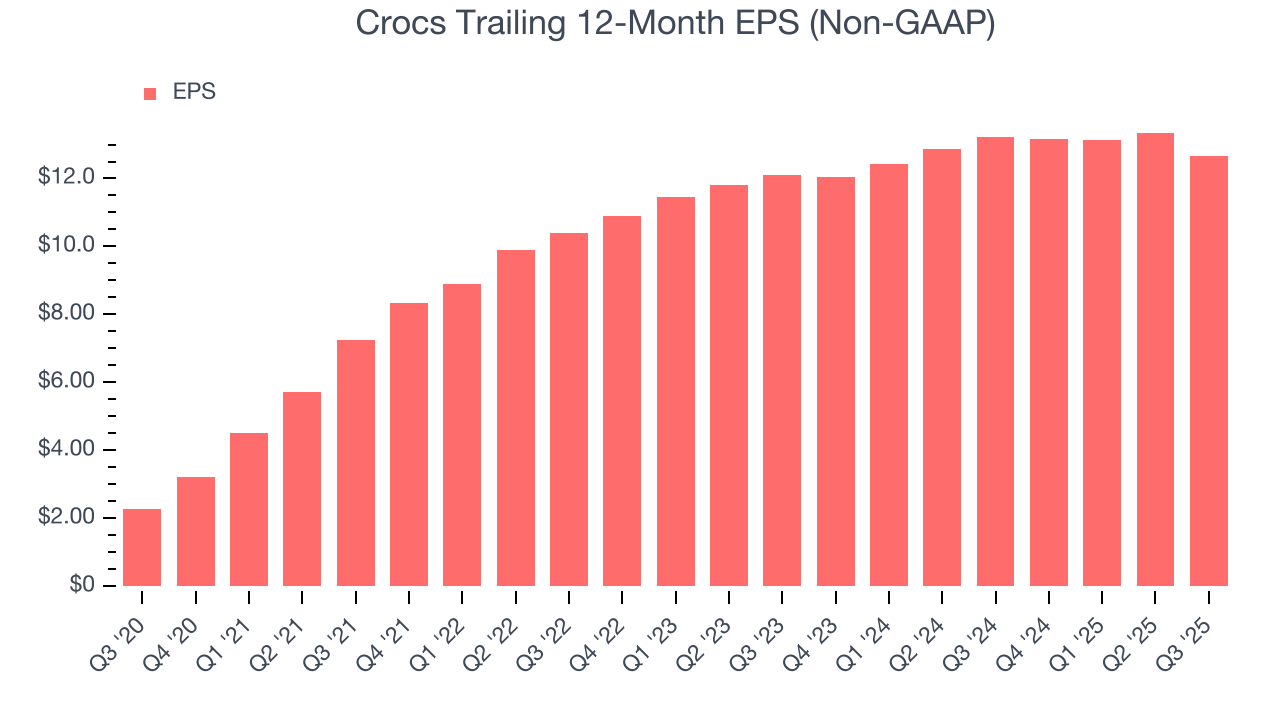
In Q3, Crocs reported adjusted EPS of $2.92, down from $3.60 in the same quarter last year. Despite falling year on year, this print easily cleared analysts’ estimates. Over the next 12 months, Wall Street expects Crocs’s full-year EPS of $12.67 to shrink by 16.2%.
8. Cash Is King
Free cash flow isn't a prominently featured metric in company financials and earnings releases, but we think it's telling because it accounts for all operating and capital expenses, making it tough to manipulate. Cash is king.
Crocs has shown robust cash profitability, giving it an edge over its competitors and the ability to reinvest or return capital to investors. The company’s free cash flow margin averaged 20.3% over the last two years, quite impressive for a consumer discretionary business.
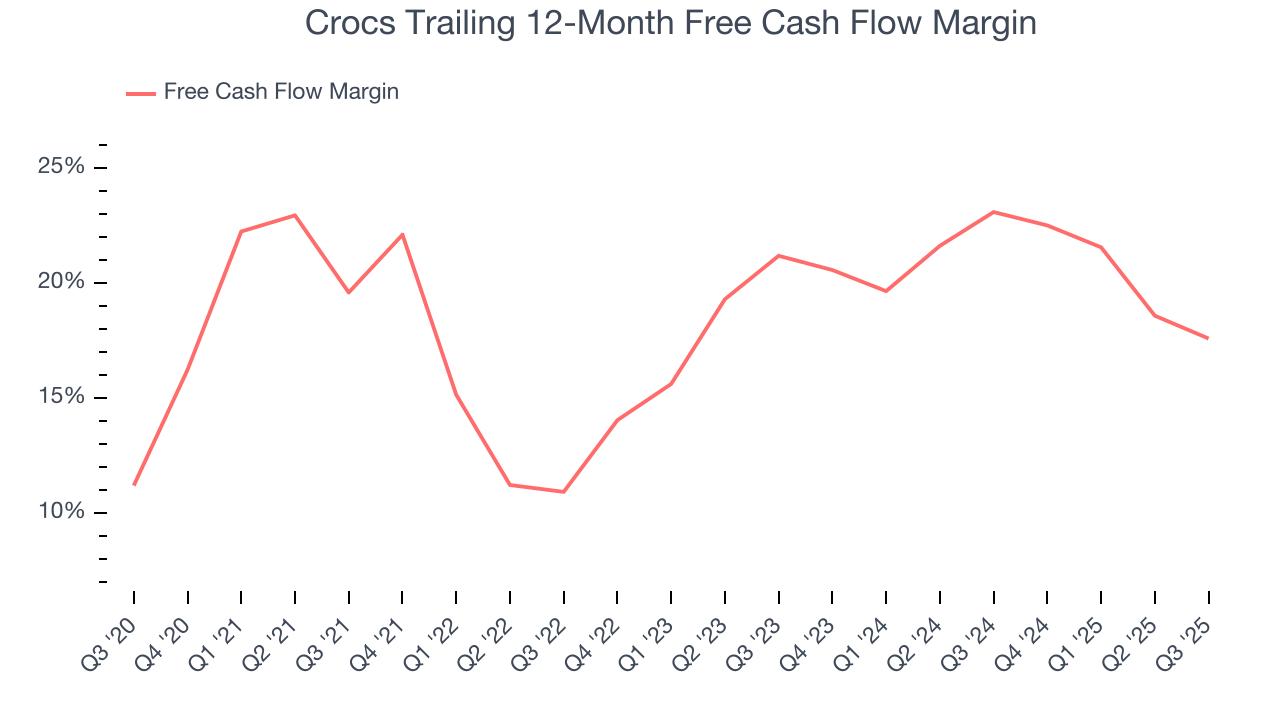
Crocs’s free cash flow clocked in at $226.2 million in Q3, equivalent to a 22.7% margin. The company’s cash profitability regressed as it was 3.6 percentage points lower than in the same quarter last year, but it’s still above its two-year average. We wouldn’t put too much weight on this quarter’s decline because investment needs can be seasonal, causing short-term swings. Long-term trends are more important.
Over the next year, analysts predict Crocs’s cash conversion will slightly improve. Their consensus estimates imply its free cash flow margin of 17.6% for the last 12 months will increase to 17.8%, it options for capital deployment (investments, share buybacks, etc.).
9. Return on Invested Capital (ROIC)
EPS and free cash flow tell us whether a company was profitable while growing its revenue. But was it capital-efficient? A company’s ROIC explains this by showing how much operating profit it makes compared to the money it has raised (debt and equity).
Although Crocs hasn’t been the highest-quality company lately, it found a few growth initiatives in the past that worked out wonderfully. Its five-year average ROIC was 29.6%, splendid for a consumer discretionary business.

We like to invest in businesses with high returns, but the trend in a company’s ROIC is what often surprises the market and moves the stock price. Over the last few years, Crocs’s ROIC has unfortunately decreased significantly. We like what management has done in the past, but its declining returns are perhaps a symptom of fewer profitable growth opportunities.
10. Balance Sheet Assessment
Crocs reported $154 million of cash and $1.71 billion of debt on its balance sheet in the most recent quarter. As investors in high-quality companies, we primarily focus on two things: 1) that a company’s debt level isn’t too high and 2) that its interest payments are not excessively burdening the business.
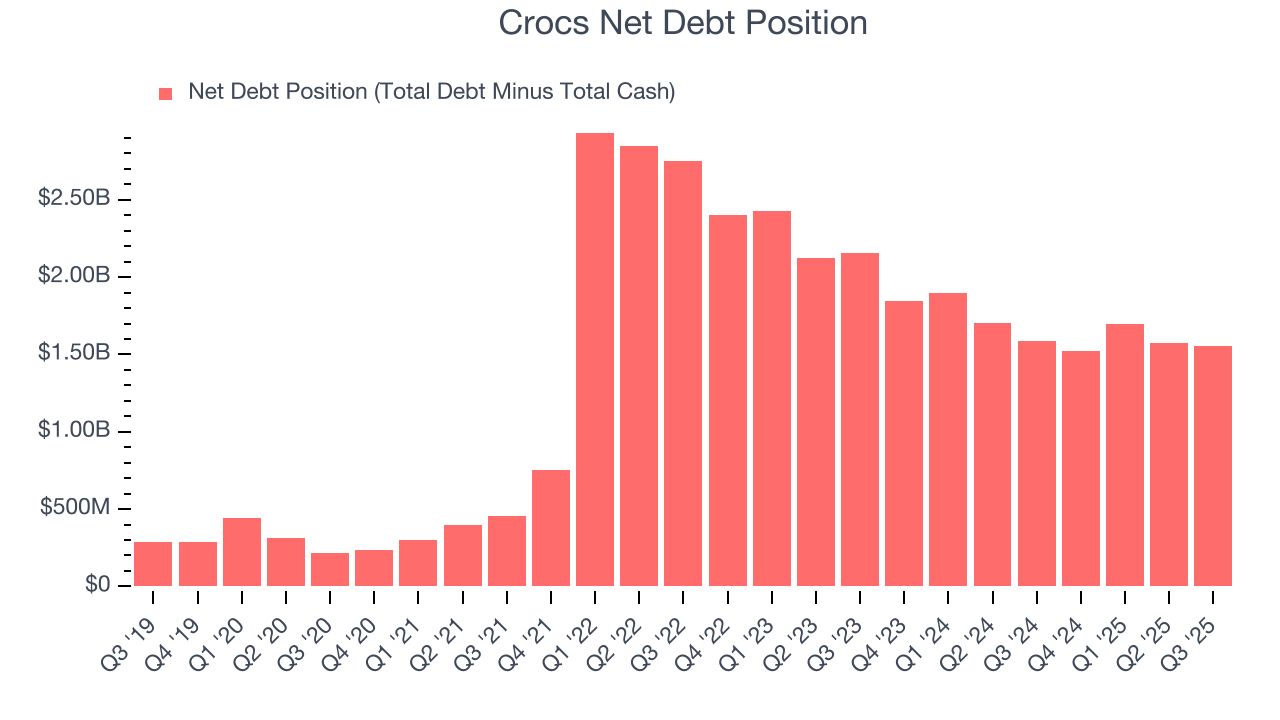
With $1.02 billion of EBITDA over the last 12 months, we view Crocs’s 1.5× net-debt-to-EBITDA ratio as safe. We also see its $46.17 million of annual interest expenses as appropriate. The company’s profits give it plenty of breathing room, allowing it to continue investing in growth initiatives.
11. Key Takeaways from Crocs’s Q3 Results
We were impressed by how significantly Crocs blew past analysts’ constant currency revenue expectations this quarter. We were also glad its EPS guidance for next quarter trumped Wall Street’s estimates. Zooming out, we think this was a good print with some key areas of upside. The stock traded up 7.4% to $91.03 immediately after reporting.
12. Is Now The Time To Buy Crocs?
Updated: December 3, 2025 at 9:58 PM EST
Are you wondering whether to buy Crocs or pass? We urge investors to not only consider the latest earnings results but also longer-term business quality and valuation as well.
Crocs doesn’t pass our quality test. To kick things off, its revenue growth was weak over the last five years, and analysts expect its demand to deteriorate over the next 12 months. And while its solid EPS growth over the last five years shows its profits are trickling down to shareholders, the downside is its Forecasted free cash flow margin suggests the company will have more capital to invest or return to shareholders next year. On top of that, its constant currency sales performance has disappointed.
Crocs’s P/E ratio based on the next 12 months is 7.3x. While this valuation is optically cheap, the potential downside is huge given its shaky fundamentals. There are better stocks to buy right now.
Wall Street analysts have a consensus one-year price target of $89.50 on the company (compared to the current share price of $88.38).

